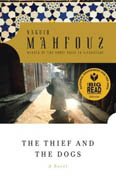The Thief and the Dogs

Naguib Mahfouz's The Thief and the Dogs (1961) is a multi-faceted story that is equal parts crime thriller, morality tale, and political allegory. The novel begins with career criminal Said Mahran's release from prison. He immediately sets off for the home of his ex-wife's new husband, desperate to settle a score with the man he feels betrayed him and hoping to reunite with his young daughter, Sana. Instead, she rejects him.
Said next visits the posh home of his friend and mentor Rauf Ilwan, a former leader of the student resistance who has thoroughly abandoned the egalitarian principles he supported during the Revolution of 1952. Sensing Said is not willing to give up his life of crime, Rauf rebuffs him, saying, "Things are no longer what they used to be."
Consumed by bitterness and motivated by a desire for revenge on the society and individuals he feels have failed him, Said's quest for vengeance carries readers from the banks of the Nile River, through the boulevards and back alleys of Cairo, to Bab al-Nasr—a medieval gateway on the outskirts of the city.
Chances for redemption and a new way of life come to him in the form of Nur, a prostitute who believes her love can transform them both, and Sheikh Ali al-Junaydi, a Sufi cleric who offers Said the opportunity to reject worldly temptation in favor of a spiritual path. Unable to accept either eros or agape, Said soon finds himself the most hunted man in Egypt—aimless, desperate, and alone.